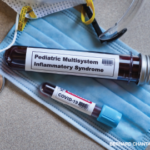
visivastudio / shutterstock.com
PRSYM 2021—Although primary COVID-19 infection has the most significant complications in adult patients, pediatric rheumatologists have also seen significant changes in their practice over the past year. With the emergence of COVID-19, the rise of a mysterious post-COVID hyperinflammatory syndrome, now known as multisystem inflammatory syndrome in children (MIS-C), was identified, and pediatric rheumatologists have played a significant role in the recognition and management of this syndrome. In addition to the challenges of MIS-C, pediatric rheumatologists have also faced managing children with rheumatic disease during the pandemic.
With these challenges in mind, Mark Gorelik, MD, and Dawn Wahezi, MD, MS, came together to discuss the pediatric rheumatology experience during COVID-19 on May 19 in a presentation titled Clinical Management of MIS-C and Rheumatic Disease During COVID.
Clinical Management of MIS-C
Dr. Gorelik, an assistant professor in Pediatric Allergy, Immunology, and Rheumatology at Columbia University Irving Medical Center, New York, and New York-Presbyterian Morgan Stanley Children’s Hospital, opened the presentation with a discussion of MIS-C. He began with a disclaimer that all of us are still learning about MIS-C and there is still very little evidence to guide management of these patients. However, the ACR has published a document, Clinical Guidance for Pediatric Patients, to help clinicians care for MIS-C patients (https://www.rheumatology.org/Practice-Quality/Clinical-Support/COVID-19-Guidance#PediatricClinicalGuidance).
One of the greatest obstacles when discussing MIS-C is the lack of homogeneity in how the diagnosis is applied in the clinical setting. Dr. Gorelik pointed out that the Centers for Disease Control and Prevention (CDC) and World Health Organization (WHO) definitions were designed to capture all cases, which may lead to over-treatment and incorrect diagnoses for some.
When reviewing published data, MIS-C definitions vary from center to center, further complicating the generalization of findings across institutions. This creates significant challenges when trying to recognize MIS-C in the clinical setting and when classifying patients for research.
In addition to varying definitions, optimal management of MIS-C has yet to be determined and differs greatly between institutions. It is currently unknown if every child should be treated with intravenous immunoglobulins (IVIG), high-dose vs. low-dose glucocorticoids and which, if any, biologics.
Dr. Gorelik highlighted two French studies, which independently demonstrated favorable outcomes in children with MIS-C who received steroids plus IVIG vs. those receiving IVIG alone.1,2 Dr. Gorelik then discussed his thought process when identifying, diagnosing and treating MIS-C, but he admitted that apart from the two French studies, this is currently an “evidence-free zone.”
One striking feature of MIS-C is that it shares many characteristics with Kawasaki disease, one of the most common forms of vasculitis in children. While reviewing the similarities, Dr. Gorelik posed a question about MIS-C: Have we really never seen this before? He then reviewed literature about Kawasaki disease complicated by myocarditis and Kawasaki shock syndrome, highlighting the manifestations and treatments of these illnesses similar to MIS-C. Ultimately, he suggested that MIS-C may be one of several hyperinflammatory syndromes that includes Kawasaki disease and Kawasaki shock syndrome.
Finally, as we reach the one-year mark for many of the initial MIS-C patients, Dr. Gorelik shared that many patients have done very well after recovery from MIS-C, providing hope for good long-term outcomes.
Caring for Children with Pediatric Rheumatic Disease
Dr. Wahezi, an associate professor in the Department of Pediatrics and division chief, Pediatric Rheumatology, Children’s Hospital at Montefiore, the Bronx, N.Y., discussed the impact of COVID-19 in children with rheumatic disease and how the pediatric rheumatology community has approached the pandemic.
As of mid-April 2021, the American Academy of Pediatrics reported over 6 million cases of COVID-19 among children in the U.S., which correlates with 13.6% of all cases in the U.S. Less than 2% of pediatric COVID-19 cases required hospitalization, and even fewer resulted in death. These numbers provide reassurance that COVID-19 does not typically affect children as severely as adults.
However, certain subsets of patients may be at increased risk for severe illness. When considering patients with rheumatic disease, the underlying disease and frequent use of immunosuppressive therapy emerged as significant concerns for patients, caregivers and clinicians. With that in mind, many questions developed, such as how COVID-19 affects those with rheumatic disease, how immunosuppression affects risk for severe complications, how to best manage immunosuppressive medications during the pandemic, and concerns about flares of the underlying rheumatic disease.
Dr. Wahezi highlighted these questions and discussed several efforts by rheumatologists to provide answers, including the efforts by the COVID-19 Global Rheumatology Alliance and the ACR to identify risk factors for severe disease and provide guidance for managing adults with rheumatic disease.
The ACR also developed a multidisciplinary task force, led by Dr. Wahezi, to create guidance for managing children with rheumatic diseases during the pandemic.3 Within a month of creating this task force, these guidance statements were drafted, revised, reviewed and accepted by the ACR Board of Directors.
Dr. Wahezi discussed the timeline and steps of this process, including using social media to elicit topics of interest to the pediatric rheumatology community. In the guidance, the task force highlighted that children with rheumatic disease are not necessarily at higher risk for severe complications if infected by COVID‑19 but should adhere to general masking and social distancing practices. In addition, the task force identified special considerations, including the mental health impact of the pandemic on children and their caregivers and the need for continued mental health assessments and providing appropriate resources.
The CDC & WHO definitions of [MIS-C] were designed to capture all cases, which may lead to over-treatment & incorrect diagnoses for some.
Dr. Wahezi also highlighted the advantages of telemedicine, emphasizing its value not only during the pandemic but also beyond. Telemedicine was important early in the pandemic to prevent delays in care and reduce anxiety toward in-person visits. Through the increased use of telemedicine, the pediatric rheumatology community has gained expertise in virtual musculoskeletal assessments using v-pGALS (video pediatric Gait, Arms, Legs and Spine).
Another topic of great interest was how to manage children with rheumatic disease during the pandemic. At the beginning of the pandemic, caregivers, patients and clinicians struggled with decisions on optimal treatment for children with rheumatic disease, and many families had significant concerns about continuing immunosuppressive therapy.
Dr. Wahezi discussed these concerns and the guidance developed by the task force. Ultimately, the data suggest that children with rheumatic disease do not appear to be at risk for severe complications from COVID-19. Thus, the task force emphasized that the primary goal in managing these patients is controlling their underlying disease. In general, the task force recommended continuing or initiating medications as needed for disease control, but allowed for some special considerations for steroids, rituximab, cyclophosphamide and symptomatic COVID-19 infections. Importantly, the pediatric guidance differs from the adult guidance statements in the setting of COVID-19 exposure and asymptomatic infection, suggesting a preference for optimizing control of the rheumatic disease.
Dr. Wahezi then reviewed the most recent observational studies, which continue to show no significantly increased risk of severe COVID-19 complications in children with rheumatic disease. She also discussed upcoming modifications of the ACR guidance statements. She reported the statements will continue to emphasize the importance of mental health assessments and the role of telemedicine, but they will also address updates regarding COVID-19 vaccination and monoclonal antibody therapy, and include new guidance on reinitiating medications post-symptomatic COVID-19 infection.
 Elizabeth Sloan, MD, is a pediatric rheumatologist who recently completed her fellowship training at UT Southwestern Medical Center, Dallas, and looks forward to joining the faculty of the Division of Pediatric Rheumatology at UT Southwestern in the fall of 2021. Dr. Sloan has also served on the ACR FIT Subcommittee and the ACR Special Committee on Pediatric Rheumatology.
Elizabeth Sloan, MD, is a pediatric rheumatologist who recently completed her fellowship training at UT Southwestern Medical Center, Dallas, and looks forward to joining the faculty of the Division of Pediatric Rheumatology at UT Southwestern in the fall of 2021. Dr. Sloan has also served on the ACR FIT Subcommittee and the ACR Special Committee on Pediatric Rheumatology.
References
- Behladjer Z, Auriau J, Meot M, et al. Addition of corticosteroids to immunoglobulins is associated with recovery of cardiac function in multi-inflammatory syndrome in children. Circulation. 2020 Dec 8;142(23):2282–2284.
- Ouldali N, Toubiana J, Antona D, et al. Association of intravenous immunoglobulins plus methylprednisolone vs immunoglobulins alone with course of fever in multisystem inflammatory syndrome in children. JAMA. 2021 Mar 2;325(9):855–864.
- Wahezi DM, Lo MS, Rubinstein TB, et al. American College of Rheumatology Guidance for the management of pediatric rheumatic disease during the COVID-19 pandemic: Version 2. Arthritis Rheumatol. 2021 Aug;73(8):e46-e59.



